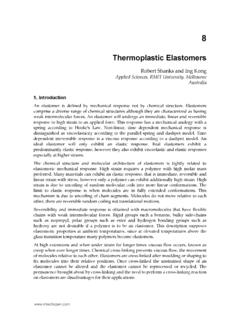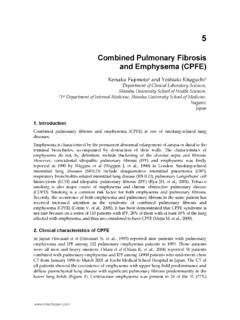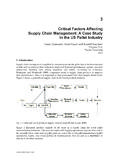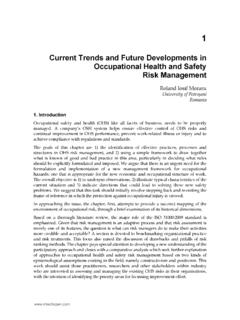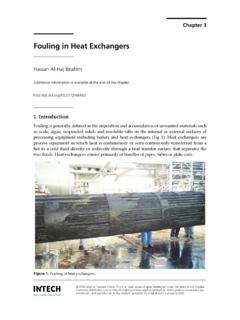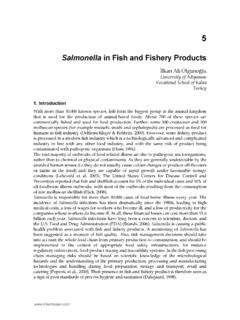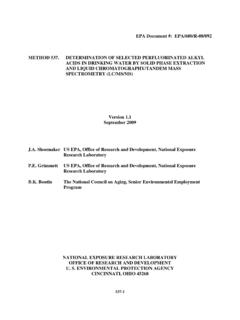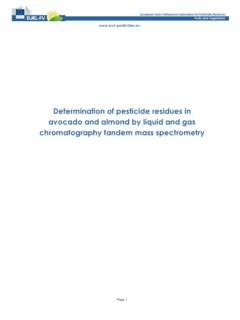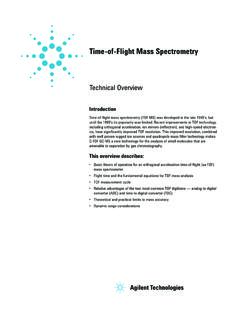Transcription of Pyrolysis-Gas Chromatography/Mass Spectrometry of ...
1 16. Pyrolysis-Gas Chromatography/Mass Spectrometry of polymeric Materials Peter Kusch Bonn-Rhine-Sieg University of Applied Sciences, Department of Applied Natural Sciences, Rheinbach, Germany 1. Introduction Structural analysis and the study of degradation properties are important in order to understand and improve performance characteristics of synthetic polymers and copolymers in many industrial applications. Polymers/copolymers cannot be analyzed in their normal state by traditional gas chromatography (GC) because of high molecular weight and lack of volatility. However, by heating these macromolecules to temperatures above 500 C, they are pyrolyzed into many individual fragmentation substances, which can be then separated chromatographically and identified by mass Spectrometry . pyrolysis technique hyphenated to gas Chromatography/Mass Spectrometry (GC/MS) has extended the range of possible tools for characterization of synthetic polymers/copolymers.
2 Under controlled conditions at elevated temperature (500 1400 C) in the presence of an inert gas, reproducible decomposition products characteristic of the original polymer/copolymer sample are formed. The pyrolysis products are chromatographically separated by using a fused silica capillary column and subsequently identified by interpretation of the obtained mass spectra or by using mass spectra libraries ( NIST, Wiley, etc.). pyrolysis methods eliminate the need for pre-treatment by performing analyses directly on the solid polymer/copolymer sample. Most of the thermal degradation results from free radical reactions initiated by bond breaking and depends on the relative strengths of the bonds that hold the molecules together. A large molecule will break apart and rearrange in a characteristic way (Moldoveanu, 2005; Wampler, 2007; Sobeih et al.)
3 , 2008). If the energy transfer to the sample is controlled by temperature, heating- rate and time, the fragmentation pattern is reproducible and characteristic for the original polymer. Another sample of the same composition heated at the same rate to the same temperature for the same period of time will produce the same decomposition products. Therefore the essential requirements of the apparatus in analytical pyrolysis are reproducibility of the final pyrolysis temperature, rapid temperature rise and accurate temperature control. Depending upon the heating mechanism, pyrolysis systems have been classified into two groups: the continuous-mode pyrolyzer (furnace pyrolyzer) and pulse-mode pyrolyzer (flash pyrolyzer) such as the heated filament, Curie-point and laser pyrolyzer. The pyrolysis unit is directly connected to the injector port of a gas chromatograph.
4 A flow of an inert carrier gas, such as helium, 344 Advanced Gas chromatography Progress in Agricultural, Biomedical and Industrial Applications flushes the pyrolyzates into the fused silica capillary column. The detection technique of the separated compounds is typically mass Spectrometry but other GC detectors have been also used depending on the intentions of the analysis (Sobeih et al., 2008). The currently commercially available pyrolysis equipment was described in detail in previous work of the author (Kusch et al., 2005). The applications of analytical pyrolysis gas Chromatography/Mass Spectrometry range from research and development of new materials, quality control, characterization and competitor product evaluation, medicine, biology and biotechnology, geology, airspace, environmental analysis to forensic purposes or conservation and restoration of cultural heritage.
5 These applications cover analysis and identification of polymers/copolymers and additives in components of automobiles, tires, packaging materials, textile fibers, coatings, half-finished products for electronics, paints or varnishes, lacquers, leather, paper or wood products, food, pharmaceuticals, surfactants and fragrances. In earlier publications of the author (Kusch, 1996; Kusch et al., 2005), the analysis and identification of degradation products of commercially available synthetic polymers and copolymers by using analytical pyrolysis hyphenated to gas chromatography /FID and gas Chromatography/Mass Spectrometry have been presented. In this chapter, examples of application of this analytical technique for identification of different polymeric materials are demonstrated. 2. Experimental Instrumentation Approximately 100 200 g of solid sample were cut out with scalpel and inserted without any further preparation into the bore of the pyrolysis solids-injector and then placed with the plunger on the quartz wool of the quartz tube of the furnace pyrolyzer Pyrojector II.
6 ( , Melbourne, Australia) (Figs. 1 2). The pyrolyzer was operated at a constant temperature of 550 C, 600 C or 700 C. The pressure of helium carrier gas at the inlet to the furnace was 95 kPa. The pyrolyzer was connected to a 7890A gas chromatograph with a series 5975C quadrupole mass spectrometer (Agilent Technologies Inc., Santa Clara, CA, ) operated in electron impact ionization (EI) mode. Two fused silica capillary columns (1) 60 m long, mm I. D. and (2) 59 m long, mm I. D. with DB-5ms stationary phase, film thickness m were used. Helium, grade (Westfalen AG, M nster, Germany). was used as a carrier gas. The gas chromatographic (GC) conditions were as follow: - (1) programmed temperature of the capillary column from 60 C (1 min hold) at 7 C. min-1 to 280 C (hold to the end of analysis) and programmed pressure of helium from kPa (1 min hold) at 7 kPa/min to kPa (hold to the end of analysis), - (2) programmed temperature of the capillary column from 75 C (1 min hold) at 7 C.
7 Min-1 to 280 C (hold to the end of analysis) and programmed pressure of helium from kPa (1 min hold) at 7 kPa/min to kPa (hold to the end of analysis), - (3) programmed temperature of the capillary column from 60 C (1 min hold) at 7 C. min-1 to 280 C (hold to the end of analysis) and constant helium flow of 1 cm min 1. during the whole analysis. The temperature of the split/splitless injector was 250 C and the split ratio was 20 : 1. The transfer line temperature was 280 C. The EI ion source temperature was kept at 230 C. The Pyrolysis-Gas Chromatography/Mass Spectrometry of polymeric Materials 345. ionization occurred with a kinetic energy of the impacting electrons of 70 eV. The quadrupole temperature was 150 C. mass spectra and reconstructed chromatograms (total ion current [TIC]) were obtained by automatic scanning in the mass range m/z 35 750 u.
8 GC/MS data were processed with the ChemStation software (Agilent Technologies) and the NIST 05 mass spectra library (Agilent Technologies). Fig. 1. pyrolysis -GC/MS system used in this work equipped with a furnace pyrolyzer Pyrojector II ( ), control module ( ), a 7890A gas chromatograph and a series 5975C quadrupole mass spectrometer (Agilent Technologies). 346 Advanced Gas chromatography Progress in Agricultural, Biomedical and Industrial Applications Fig. 2. Schematic view of the furnace pyrolyzer Pyrojector II ( , Melbourne, Australia). Samples Samples of an unknown industrial plastic, a valve rubber, a car tire rubber, membranes of hydraulic cylinders from the automotive industry, an O-ring seal, dental filling material and recycled polyethylene were used in the investigation. Pyrolysis-Gas Chromatography/Mass Spectrometry of polymeric Materials 347.
9 3. Results and discussion Analytical pyrolysis of synthetic organic polymers/copolymers pyrolysis gas Chromatography/Mass Spectrometry (Py GC/MS) is used to characterize the structure of synthetic organic polymers and copolymers, polymer blends, biopolymers and natural resins. The traditional physical methods may only be applied to the analysis of technical organic polymers. Several chemical analysis techniques like UV-, FTIR- and NMR- spectroscopy, thermogravimetric analysis (TGA), size exclusion chromatography (SEC, GPC), headspace GC (HS GC) or recently solid phase microextraction (SPME) with GC/MS (Kusch & Knupp, 2002, 2004; Hakkarainen, 2008) have been established during the last four decades for characterization of macromolecules. These non-destructive methods offer information about functional groups, structural elements, thermal stability, molecular weight, and volatile components.
10 pyrolysis GC/MS is a destructive analytical technique. The most frequent use of this technique is the analysis of polymers and copolymers. Typical fields of interest and application (Hummel & Fischer, 1974; Hummel & Scholl, 1988; Hallensleben & Wurm, 1989;. Moldoveanu, 2005; Kusch et al., 2005; Wampler, 2007) are: - polymer identification by comparison of pyrograms and mass spectra with known references, - qualitative analysis and structural characterization of copolymers, sequence statistics of copolymers, differentiation between statistical and block polymers, - determination of the (micro) structure of polymers (degree of branching and cross- linking, compositional analysis of copolymers and blends, co-monomer ratios, sequence distributions, analysis of end-groups), - determination of the polymers steric structure (stereoregularity, tacticity, steric block length, and chemical inversions), - investigation of thermal stability, degradation kinetics and oxidative thermal decomposition of polymers and copolymers, - determination of monomers, volatile organic compounds (VOC)


